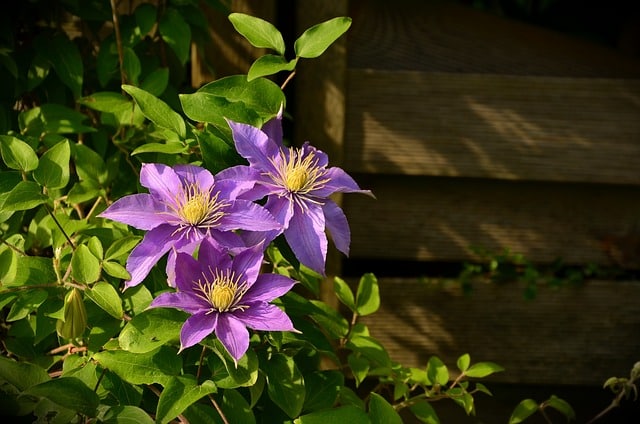Twining and Vining – Backyard Gardener
I started thinking about vines when I found a turn-of-the-last-century photograph of my house and noticed that a vine used to climb up the pillar to the right of the front door. At the time, the large front porch, so beloved of realtors, was almost completely obscured by a curtain of vines. They must have been trained on wires to provide a privacy screen for porch sitters desirous of avoiding the prying eyes of their suburban neighbors.
My affection for vines was late in developing. In my formative years, I had little exposure to them, and the impressions I received were decidedly negative. At home, my father was perpetually annoyed by the English ivy that persisted in climbing the side of our brick house. On our vacation property, the omnipresent poison ivy cloaked everything in its path. Still, more English ivy rampaged up the tree by our summer cottage disturbing my father’s well-earned summer respite. As a teenager, I earned extra money by tearing down the greenery that stood between him and perfect tranquility.
Just about the only approved aerial plant at my childhood home was a climbing “Peace” rose, and that seemed to be exceedingly slow about the business of rising to great heights. Our neighbors, on the other hand, had an old-fashioned pink rambling rose that grew through flood and drought, not to mention the rigorous western New York winters. Though my father was an avid gardener, we had no morning glories or clematis, no honeysuckle or wisteria. I suppose they were out of fashion at the time.
Now climbers are fashionable again. You can hardly call yourself a suburban gardener without a Clematis jackmanii somewhere on your property, particularly if it twines around the lamppost flanking your front walk . On one street near my old house I know of one lamppost that has been completely engulfed by Clematis montana rubens. On summer evenings the lamp sheds a very faint light and an overpowering vanilla fragrance.
The catalogs are also full of morning glories, including the faithful blue variety, as well as rediscovered heirlooms like ‘Grandpa Ott’, and modern cultivars that look as if the blossoms have been tied-dyed. Honeysuckle lovers can find myriad varieties, including some that the vendors claim are not invasive. You can find vines for semi-shade such as hardy kiwi, silver lace and climbing hydrangea. There are old and new-fangled varieties of climbing and rambling roses, including the celebrated ‘Lady Banks’ rose, which can take over entire trees.
At this point in time, finances do not permit me to replace the ornamental balcony that once adorned the peak of my house, but I can reproduce the vine that embellished the pillar by the door. Since, with any luck, the whole house will be painted in a year or two, I will restrict myself to an annual climber for the time being. The plant will face south and be somewhat shaded by the porch overhang. A morning glory might be a possibility, although it might not achieve its maximum potential. Thunbergia alata ‘Alba Oculata’, a relative of the blace-eyed-susan vine, is somewhat shade-tolerant, and has distinctive white flowers with a black eye. These would be striking framing the porch. I could, of course, train English ivy up the pillar, and just tear it down before the arrival of the painters. Six weeks later it would be fully recovered.
Once my house has fulfilled its Victorian destiny and become a “painted lady”, I will plant a more permanent climber. I could use Fiveleaf Akebia Vine (Akebia quinata), which has purple flower clusters followed by purple fruits, and can grow, unpruned, to a height of 40’. I may combine the Akebia with a climbing rose that can thrive in partial shade, such as the white ‘City of York’ or the repeat blooming ‘Golden Star.’ The latter would look especially attractive, I think, combined with the purple Akebia blossoms. I have a weakness for white roses, and if I give in to it in this situation, I might also try ‘Climbing Mrs. Herbert Stevens’, which can grow to 10’. All three roses adapt well to partial shade, so I can count on having more than two or three blossoms to enjoy.
Once I have jumped on the climbing and rambling bandwagon, I will undoubtedly have to have climbing plants all over the property. Fortunately, every nursery, garden center, mega-merchandiser, catalog and internet vendor offers an array of tutueurs, trellises, arbors, pergolas and pillars for sale. With only a small effort I will be able to combine historical styles and building materials with wild abandon. I can see it now—a little bit of France’s famed Rosarie de l’Hay executed in bent twigs and stainless steal in my own suburban backyard. All I need to make my aesthetic concept totally eclectic is a few 1950’s vintage metal lawn chairs and a German garden gnome. The neighbors will be in awe of my artistic vision.






